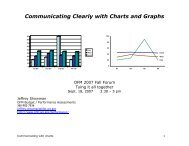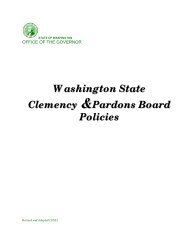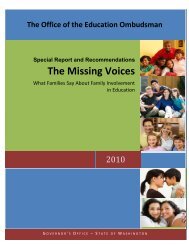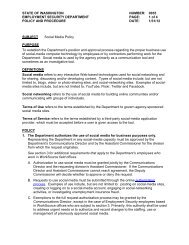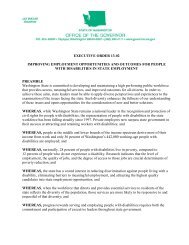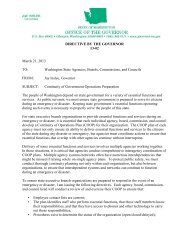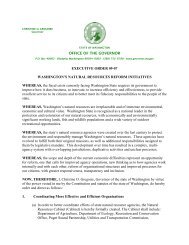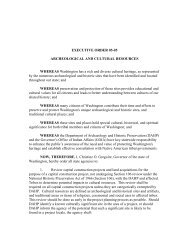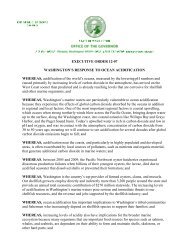Higher Education Funding Task Force
Higher Education Funding Task Force
Higher Education Funding Task Force
You also want an ePaper? Increase the reach of your titles
YUMPU automatically turns print PDFs into web optimized ePapers that Google loves.
<strong>Funding</strong> Our Future:<br />
A Financial Blueprint for Strengthening<br />
<strong>Higher</strong> <strong>Education</strong> in Washington State<br />
Recommendations of the Governor’s <strong>Higher</strong> <strong>Education</strong> <strong>Funding</strong> <strong>Task</strong> <strong>Force</strong><br />
Executive Summary<br />
Washington’s future economic vitality will depend on expanding access to high-quality postsecondary<br />
education. By 2018, two-thirds of the jobs — and almost all good-paying jobs — will require workers with<br />
college degrees.<br />
The <strong>Higher</strong> <strong>Education</strong> <strong>Funding</strong> <strong>Task</strong> <strong>Force</strong> was appointed by the Governor to develop a plan for tackling<br />
this challenge.<br />
In the long term, Washington needs to renew and reshape its commitment to higher education and make<br />
sure the next generation is equipped to compete for the best jobs available. In the short term, the state<br />
must embrace a new way of delivering higher education, with a new incentive system that ties college<br />
graduates to state funds, a new source of revenue for college scholarships, and improved accountability<br />
at all six public universities.<br />
The <strong>Higher</strong> <strong>Education</strong> <strong>Funding</strong> <strong>Task</strong> <strong>Force</strong> recommends:<br />
• Increasing the number of Washington residents graduating with bachelor’s degrees from<br />
Washington’s colleges and universities, especially in high demand fields — science, technology,<br />
engineering, and math.<br />
• Providing the universities with increased flexibility to set tuition — linked to the level of state support<br />
and to the tuition charged by each institution’s peer colleges.<br />
• Expanding financial assistance to low- and middle- income students through a combination of private<br />
and public strategies, including a $1 billion endowment fund and tax incentives.<br />
• Holding each public university accountable for graduating more students with bachelor’s degrees,<br />
giving incoming students credit for high school coursework, community college studies and prior<br />
learning experiences, and revamping some academic programs.<br />
HIGHER EDUCATION FUNDING TASK FORCE






